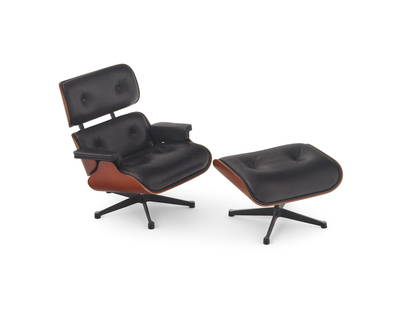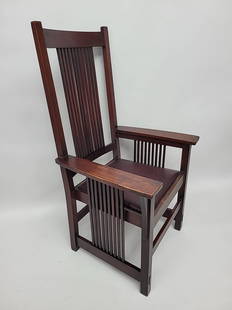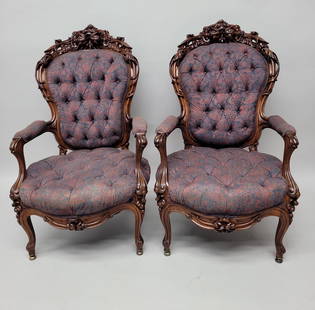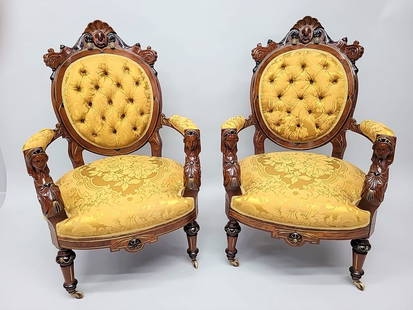
Charles & Ray Eames lounge chairs & ottomans, pr
Charles & Ray Eames Sale History
View Price Results for Charles & Ray EamesRelated Lounge Chairs
More Items from Charles & Ray Eames
View MoreRecommended Chairs
View More




Item Details
Description
Charles Eames (1907-1978) & Ray Eames (1912-1988) for Herman Miller
670 / 671 lounge chairs and ottomans, pair
Zeeland, Michigan, 1977
rosewood, brown leather, aluminum
sticker labels and dates
both examples in excellent vintage condition and dated December 29, 1977
chair: 34"w x 32"d x 32 1/2"h; ottoman: 26"w x 22"d x 17"h
670 / 671 lounge chairs and ottomans, pair
Zeeland, Michigan, 1977
rosewood, brown leather, aluminum
sticker labels and dates
both examples in excellent vintage condition and dated December 29, 1977
chair: 34"w x 32"d x 32 1/2"h; ottoman: 26"w x 22"d x 17"h
Condition
Very subtle signs of age. Excellent vintage condition.
Biography:
Mid-century design icons Charles and Ray Eames had a groundbreaking partnership that lasted nearly 40 years. Charles was born in St. Louis in 1907 and studied architecture locally at Washington University. After two years, Charles left the traditional institution because he favored the philosophies of Frank Lloyd Wright and other modernists. While working in St. Louis as an architect, Charles married Catherine Woermann in 1929 and they had a daughter. In 1939, Charles moved with his family to Michigan to study at the Cranbrook Academy of Art in Bloomfield Hills through an invitation from architect Eliel Saarinen. Before long, Charles began teaching and was named head of the industrial design department. With Eliel Saarinen’ son, Eero, Charles generated award-winning furniture designs for a contest sponsored by New York's Museum of Modern Art. On this project, Charles met Ray (née Bernice Alexandria) Kaiser who helped with graphic design. Ray was born in 1912 in Sacramento, California. In 1929, Ray moved with her widowed mother to New York City, where she pursued fashion design and studied art with German abstract expressionist Hans Hofmann. After Ray’s mother died in 1940, she left New York to audit classes at Cranbrook, where Charles Eames was one of her teachers and mentors. In 1941, Charles divorced his first wife Catherine and he and Ray were married shortly thereafter, establishing an enduring personal and artistic collaboration. Heading west to Los Angeles, Charles and Ray settled in a two-bedroom apartment designed by Richard Neutra, where they began experimenting with molding plywood into compound curves; their focus was on designing everyday objects of high quality to be produced at reasonable cost. During the day, Ray painted and designed covers for Arts & Architecture magazine; at night, she and Charles worked together producing experimental designs. Their accomplishments in molded plywood included sculptures, toys, chairs, and mass-produced leg splints used in World War II by the U.S. Navy. Charles and Ray’s first successful product design was a simple plywood chair curved to accommodate the human body ergonomically and provide maximum comfort. It was produced by the Herman Miller Company and marketed as an affordable chair suitable for all modern households. This concept was leveraged for the Lounge Chair Wood (LCW) and Dining Chair Wood (DCW), both of which have had a profound and lasting impact on 20th-century furniture design in America. Other popular designs that came out of the Eames Office include: the 670 / 671 lounge chair and ottoman, the ESU modular storage unit, the FSW-6 folding screen, plus various chairs with Eiffel Tower bases and/or fiberglass shell seats. Following the success of the LCW and DCW, Charles and Ray focused on residential construction. Arts & Architecture magazine sponsored a project called Case Study Houses, aimed to provide solutions to postwar housing shortages by engaging young architects to design and build prototype ‘case study’ homes. The Eames Case Study House #8, which became their family residence, was built in 1951 in Pacific Palisades, California from standard materials. The layout of the house, with its flexible plan, replaced traditional, fixed-room arrangements and became a hallmark of postwar modern architecture. Charles and Ray continued to produce furniture during the latter part of their career, but they shifted their emphasis increasingly to communicating through various forms of media. This included design exhibitions and publications as well as instructional films, such as the iconic Powers of Ten. In this unusually creative partnership, every Eames project was a team effort geared to broadcast their message. After Charles’ death in 1978, the Eames Office was disbanded and Ray Eames donated its archives to the Library of Congress. She died 10 years to the day after Charles in August of 1988. The Eames’ design philosophy and products continue to exert a powerful influence in America and abroad.
Biography:
Mid-century design icons Charles and Ray Eames had a groundbreaking partnership that lasted nearly 40 years. Charles was born in St. Louis in 1907 and studied architecture locally at Washington University. After two years, Charles left the traditional institution because he favored the philosophies of Frank Lloyd Wright and other modernists. While working in St. Louis as an architect, Charles married Catherine Woermann in 1929 and they had a daughter. In 1939, Charles moved with his family to Michigan to study at the Cranbrook Academy of Art in Bloomfield Hills through an invitation from architect Eliel Saarinen. Before long, Charles began teaching and was named head of the industrial design department. With Eliel Saarinen’ son, Eero, Charles generated award-winning furniture designs for a contest sponsored by New York's Museum of Modern Art. On this project, Charles met Ray (née Bernice Alexandria) Kaiser who helped with graphic design. Ray was born in 1912 in Sacramento, California. In 1929, Ray moved with her widowed mother to New York City, where she pursued fashion design and studied art with German abstract expressionist Hans Hofmann. After Ray’s mother died in 1940, she left New York to audit classes at Cranbrook, where Charles Eames was one of her teachers and mentors. In 1941, Charles divorced his first wife Catherine and he and Ray were married shortly thereafter, establishing an enduring personal and artistic collaboration. Heading west to Los Angeles, Charles and Ray settled in a two-bedroom apartment designed by Richard Neutra, where they began experimenting with molding plywood into compound curves; their focus was on designing everyday objects of high quality to be produced at reasonable cost. During the day, Ray painted and designed covers for Arts & Architecture magazine; at night, she and Charles worked together producing experimental designs. Their accomplishments in molded plywood included sculptures, toys, chairs, and mass-produced leg splints used in World War II by the U.S. Navy. Charles and Ray’s first successful product design was a simple plywood chair curved to accommodate the human body ergonomically and provide maximum comfort. It was produced by the Herman Miller Company and marketed as an affordable chair suitable for all modern households. This concept was leveraged for the Lounge Chair Wood (LCW) and Dining Chair Wood (DCW), both of which have had a profound and lasting impact on 20th-century furniture design in America. Other popular designs that came out of the Eames Office include: the 670 / 671 lounge chair and ottoman, the ESU modular storage unit, the FSW-6 folding screen, plus various chairs with Eiffel Tower bases and/or fiberglass shell seats. Following the success of the LCW and DCW, Charles and Ray focused on residential construction. Arts & Architecture magazine sponsored a project called Case Study Houses, aimed to provide solutions to postwar housing shortages by engaging young architects to design and build prototype ‘case study’ homes. The Eames Case Study House #8, which became their family residence, was built in 1951 in Pacific Palisades, California from standard materials. The layout of the house, with its flexible plan, replaced traditional, fixed-room arrangements and became a hallmark of postwar modern architecture. Charles and Ray continued to produce furniture during the latter part of their career, but they shifted their emphasis increasingly to communicating through various forms of media. This included design exhibitions and publications as well as instructional films, such as the iconic Powers of Ten. In this unusually creative partnership, every Eames project was a team effort geared to broadcast their message. After Charles’ death in 1978, the Eames Office was disbanded and Ray Eames donated its archives to the Library of Congress. She died 10 years to the day after Charles in August of 1988. The Eames’ design philosophy and products continue to exert a powerful influence in America and abroad.
Buyer's Premium
- 30% up to $100,000.00
- 25% up to $1,000,000.00
- 15% above $1,000,000.00
Charles & Ray Eames lounge chairs & ottomans, pr
Estimate $7,000 - $9,000
96 bidders are watching this item.
Shipping & Pickup Options
Item located in Oak Park, IL, usOffers In-House Shipping
Local Pickup Available
Payment

TOP





































































